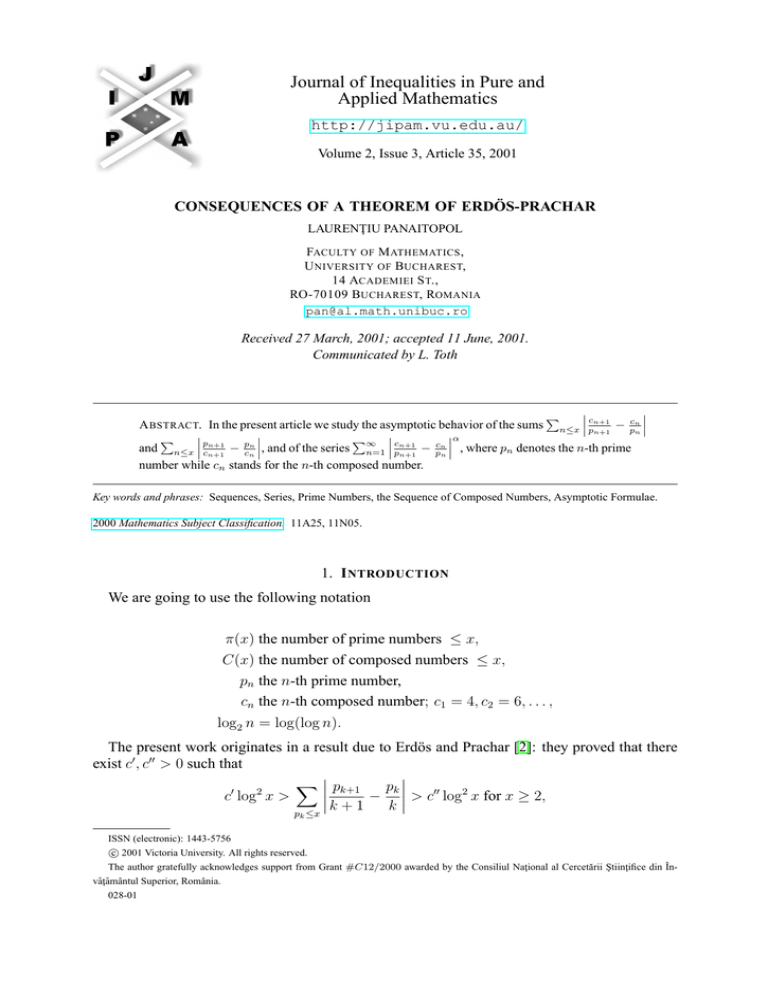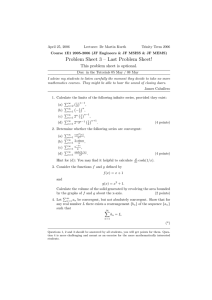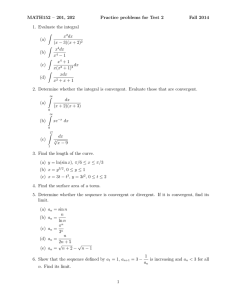
Journal of Inequalities in Pure and
Applied Mathematics
http://jipam.vu.edu.au/
Volume 2, Issue 3, Article 35, 2001
CONSEQUENCES OF A THEOREM OF ERDÖS-PRACHAR
LAURENŢIU PANAITOPOL
FACULTY OF M ATHEMATICS ,
U NIVERSITY OF B UCHAREST,
14 ACADEMIEI S T.,
RO-70109 B UCHAREST, ROMANIA
pan@al.math.unibuc.ro
Received 27 March, 2001; accepted 11 June, 2001.
Communicated by L. Toth
P
cn A BSTRACT. In the present article we study the asymptotic behavior of the sums n≤x pcn+1
−
pn n+1
α
P
P
n+1
∞ and n≤x pcn+1
− pcnn , and of the series n=1 pcn+1
− pcnn , where pn denotes the n-th prime
n+1
number while cn stands for the n-th composed number.
Key words and phrases: Sequences, Series, Prime Numbers, the Sequence of Composed Numbers, Asymptotic Formulae.
2000 Mathematics Subject Classification. 11A25, 11N05.
1. I NTRODUCTION
We are going to use the following notation
π(x) the number of prime numbers ≤ x,
C(x) the number of composed numbers ≤ x,
pn the n-th prime number,
cn the n-th composed number; c1 = 4, c2 = 6, . . . ,
log2 n = log(log n).
The present work originates in a result due to Erdös and Prachar [2]: they proved that there
exist c0 , c00 > 0 such that
X pk+1
pk 2
2
0
00
c log x >
k + 1 − k > c log x for x ≥ 2,
pk ≤x
ISSN (electronic): 1443-5756
c 2001 Victoria University. All rights reserved.
The author gratefully acknowledges support from Grant #C12/2000 awarded by the Consiliul Naţional al Cercetării Ştiinţifice din Învăţământul Superior, România.
028-01
2
L AUREN ŢIU PANAITOPOL
that is
X pk+1
pk 2
k + 1 − k log x.
p ≤x
(1.1)
k
In a recent paper [3], Panaitopol proved that
X k + 1
k
log log x.
(1.2)
−
pk+1
p
k
p ≤x
k
The proofs of these results rely on the following result due to Schnirelmann: if for x positive
and n a positive integer one denotes by M (n, x) the number of the indices k such that pk ≤ x
and pk+1 − pk = n, then
x X1
M (n, x) < c000 2
,
d
log x
d|n
000
where c is a positive constant.
In the present paper, several well known results will be used:
x
(1.3)
π(x) ∼
;
log x
pn ∼ n log n;
(1.4)
(1.5)
the series
∞
X
n=3
1
is convergent if and only if α > 1;
n log n(log log n)α
(1.6)
1
= log log x + O(1);
n
log
n
2≤n≤x
(1.7)
X 1
= log x + O(1);
n
2≤n≤x
(1.8)
log p
∼ log x.
p
p prime ≤x
X
X
We also need the following result of Bojarincev [1]:
n
(1.9)
cn = n +
· un , where lim un = 1.
n→∞
log n
2. P ROPERTIES OF THE S EQUENCE pnn
n≥1
P
n+1
n The series ∞
n=1 pn+1 − pn is divergent by (1.2). In connection with this fact we prove the
following result.
Theorem 2.1. The series
∞ X
n + 1
n
1
·
−
pn+1
pn (log log n)α
n=3
is convergent if and only if α > 1.
Let us first prove the following auxiliary result.
J. Inequal. Pure and Appl. Math., 2(3) Art. 35, 2001
http://jipam.vu.edu.au/
C ONSEQUENCES
OF
E RDÖS -P RACHAR THEOREM
3
Lemma 2.2. Consider the sequences (an )n≥1 , (xn )n≥1 and (sn )n≥1 , where sn =
sequence (sn xn )n≥1 is convergent, then one of the series
∞
X
sn (xn+1 − xn ) and
n=1
∞
X
Pn
i=1
ai . If the
an x n
n=1
is convergent if and only if the other one is convergent.
P∞
Proof. If
But
n=1 sn (xn+1 − xn ) is convergent, then limn→∞ sn (xn+1 − xn ) = 0.
limn→∞ sn xn = k for some k ∈ R, hence limn→∞ sn xn+1 = k and limn→∞ (sn+1 − sn )xn+1
= 0.
P
On the other hand, if ∞
n=1 an xn is convergent, then
limn→∞ an+1 xn+1 = 0, hence
n )xn+1 = 0.
P limn→∞ (sn+1 − sP
Now let us denote Sn = ni=1 ai xi and σn = ni=1 si (xi+1 − xi ). Then for each p we have
(2.1)
Sn+p − Sn = σn+p − σn + sn+p xn+p − sn+1 xn+1 + (sn+1 − sn )xn+1 .
Since we have just seen that in either case we have lim (sn+1 − sn )xn+1 = 0, relation (2.1)
n→∞
implies that in either case one of the sequences (Sn )n≥1 and (σn )n≥1 is Cauchy if and only if
the other one is Cauchy. Now, by Cauchy’s criterion, one of the two series is convergent if and
only if the other one is convergent.
Proof of Theorem
2.1. If α ≤ 0, then the series is divergent by (1.2). Next assume α > 0 and
n+1
1
.
choose an = pn+1 − pnn and xn = (log log
n)α
If we consider the function f : [n, n + 1] → R, f (x) = (log log x)−α , then Lagrange’s
theorem implies
(log log(n + 1))−α − (log log n)−α = −
α(log log θn )−α−1
,
θn log θn
where n < θn < n + 1. Since θn ∼ n, it follows that
(2.2)
xn+1 − xn ∼
−α
.
n log n(log log n)α+1
By (1.2) and (1.4) it follows that sn log log n and (2.2) implies
(2.3)
sn (xn+1 − xn ) −
1
.
n log n(log log n)α
If α > 1, then we have
lim sn xn = lim
n→∞
n→∞
log log n
= 0,
(log log n)α
while for α = 1P
we get limn→∞ sn xn = P
1. Thus, for α ≥ 1, the above lemma implies that
∞
one of the series n=3 sn (xn+1 − xn ) and ∞
is convergent if and only if the other one
n=3 an xnP
is convergent. In view of (1.5) and (2.3), the series ∞
n=3 an xn is convergent for α > 1 and
divergent for α = 1.
Finally, if 0 < α < 1, then
n + 1
n + 1
n
1
n
xn − >
− pn+1
pn
log log n pn+1
pn
and the desired conclusion follows.
J. Inequal. Pure and Appl. Math., 2(3) Art. 35, 2001
http://jipam.vu.edu.au/
4
L AUREN ŢIU PANAITOPOL
Consequence 1. If α > 1, then the series
α
∞ X
n + 1
n pn+1 − pn n=1
is convergent.
Proof. We have
α−1
α−1
n + 1
n
n
+
1
n
≤ max
,
.
pn+1 − pn pn+1 pn
K
n+1
1
For K > 0 and n ≥ 3, we have (log n)
∼
α−1 < (log log n)α and (1.4) implies that p
n+1
0
There exists K such that
α
n + 1
n
n
+
1
n
1
< K0 −
−
pn+1
pn
pn+1
pn (log log n)α
α
P
n+1
n and the convergence of the series ∞
−
follows by Theorem 2.1.
n=1 pn+1
pn
3. P ROPERTIES OF THE S EQUENCE
Since cn ∼ n (see (1.9)), for the sequence
those of the sequence pnn
.
cn
pn
n
pn
∼
1
.
log n
cn
pn
n≥1
we obtain properties which are similar to
n≥1
n≥1
In connection with (1.2) we have the following fact.
Theorem 3.1. We have
X ck+1
c
k
−
pk+1 pk log log x
p ≤x
k
for every x > e.
Proof. If we denote αk = ck+1 − ck − 1, then it follows that αk = 0 if ck + 1 is a composed
number, and αk = 1 if ck + 1 is prime. In the last case ck + 1 = pm . Setting k = k(m), we
deduce by (1.9) that ck − k ∼ logk k and log k ∼ log ck ∼ log pm ∼ log m. It then follows that
pm
k(m) − pm ∼ − log
and (1.4) implies that
m
(3.1)
k(m) = pm − mym with lim ym = 1.
m→∞
We have by (1.9)
ck+1
ck
ck + 1 + αk
ck
αk + 1 ck (pk+1 − pk )
−
=
−
=
−
pk+1 pk
pk+1
pk
pk+1
pk pk+1
αk + 1 k(pk+1 − pk )
kuk
=
−
−
pk+1
pk pk+1
(log k)pk pk+1
k+1
k
αk
kuk (pk+1 − pk )
=
−
+
−
.
pk+1
pk
pk+1
(log k)pk pk+1
We have the inequality
k + 1
αk kuk (pk+1 − pk ) k
−
(3.2) − − pk+1
pk
pk+1 (log k)pk pk+1 ck+1
ck k + 1
k αk kuk (pk+1 − pk ) −
≤
− +
+
.
≤
pk+1 pk pk+1
pk
pk+1 (log k)pk pk+1 J. Inequal. Pure and Appl. Math., 2(3) Art. 35, 2001
http://jipam.vu.edu.au/
C ONSEQUENCES
OF
E RDÖS -P RACHAR THEOREM
5
We have
kuk (pk+1 − pk )
k(pk+1 − pk )
pk+1 − pk
∼
=
.
3
2
(log k)pk pk+1
k log k
k log3 k
P
pn+1 −pn
Panaitopol proves in [4] that for β > 2 the series ∞
n=2 n logβ n is convergent, hence the series
P∞ kuk (pk+1 −pk )
k=2 (log k)pk pk+1 is also convergent.
We have furthermore
∞
X
X0 1
αk
=
,
p
p
k+1
k+1
k=1
P
where 0 extends over the values of k such that αk = 1, that is, ck + 1 = pm . Then by (2.2)
and (1.4) we get
pk+1 ∼ pk ∼ ppm ∼ m log2 m.
(3.3)
P∞
P
1
Since the series ∞
k=1
m=2 m log2 m is convergent, it then follows that the series
convergent. Now (3.2) implies that
X
n n X
ck+1
k + 1
c
k
k
pk+1 − pk =
pk+1 − pk + O(1)
k=1
αk
pk+1
is also
k=1
and the desired conclusion follows.
Analogously to the Erdös-Prachar theorem, we shall prove the following fact.
Theorem 3.2. We have
X pk+1 pk 2
ck+1 − ck log x
p ≤x
k
for every x > 1.
Proof. We have
pk+1 pk
(3.4)
−
=
ck+1
ck
pk+1
pk
−
k+1
k
+ pk
1
ck+1 − ck
−
k(k + 1)
ck+1 ck
(pk+1 − pk )(k + 1 − ck+1 )
+
.
(k + 1)ck+1
By (1.9) we get
X (pk+1 − pk )(k + 1 − ck+1 ) (k + 1)ck+1
pk ≤x
X (pk+1 − pk )uk+1
c
log(k + 1)
pk ≤x k+1
π(x)
X
pk+1 − pk
= O
k log k
k=2
π(x)
X
x
1
1
.
= O
+
pk
−
π(x) log π(x) k=3
(k − 1) log(k − 1) k log k
=−
By (1.3) we have π(x) log π(x) ∼ x,
1
1
1
pk log k
pk
−
∼ 2 2 ∼
(k − 1) log(k − 1) k log k
k
k log k
J. Inequal. Pure and Appl. Math., 2(3) Art. 35, 2001
http://jipam.vu.edu.au/
6
L AUREN ŢIU PANAITOPOL
and (1.7) implies
(3.5)
X (pk+1 − pk )(k + 1 − ck+1 )
= O(log x).
(k
+
1)c
k+1
p ≤x
k
We have also
X 1
ck+1 − ck pk
−
k(k + 1)
ck+1 ck
p ≤x
k
X 00 X0 1
p
1
k
pk
+2
≤
−
ck (ck + 2) ,
k(k
+
1)
c
(c
+
1)
k
k
pk ≤x
pk ≤x
P0
P
where
extends over the values of k such that ck + 1 is a prime number, while 00 extends
over the values of k such that ck + 1 = pm is composed. By (1.9) we deduce
!
X k log k
X 00 pk (ck − k)(ck + k + 1) · k 2 log k
k(k + 1)ck (ck + 1) = O
4
k
pk ≤x
pk ≤x
!
X 1
=O
= O(log x).
k
p ≤x
k
By (1.4) and (1.8) it follows that
X 0 ck log ck
X0 pk
∼
ck (ck + 2) ck (ck + 2)
p ≤x
k≤π(x)
k
X 0 log(ck + 1)
ck + 1
ck ≤x
X log pm
=
= O(log x).
p
m
p ≤x
∼
m
Thus
1
c
−
c
k+1
k
= O(log x).
(3.6)
pk −
k(k
+
1)
c
c
k+1
k
pk ≤x
P
pk+1 pk Now by (1.1), (3.4), (3.5) and (3.6) it follows that pk ≤x ck+1 − ck log2 x and the proof is
completed.
X
R EFERENCES
[1] A.E. BOJARINCEV, Asymptotic expressions for the nth composite number, Ural. Gos. Univ. Mat.
Zap., 6 (1967), 21–43 (in Russian).
[2] P. ERDÖS AND K. PRACHAR, Sätze und Probleme über pk /k, Abh. Math. Sem. Univ. Hamburg,
25 (1961/1962), 251–256.
[3] L. PANAITOPOL, On Erdös-Prachar Theorem, An. Univ. Bucureşti Mat., 2 (1999), 143–148.
[4] L. PANAITOPOL, On the sequence of the differences of consecutive prime numbers, Gaz. Mat. Ser.
A, 79 (1974), 238–242 (in Romanian).
J. Inequal. Pure and Appl. Math., 2(3) Art. 35, 2001
http://jipam.vu.edu.au/






